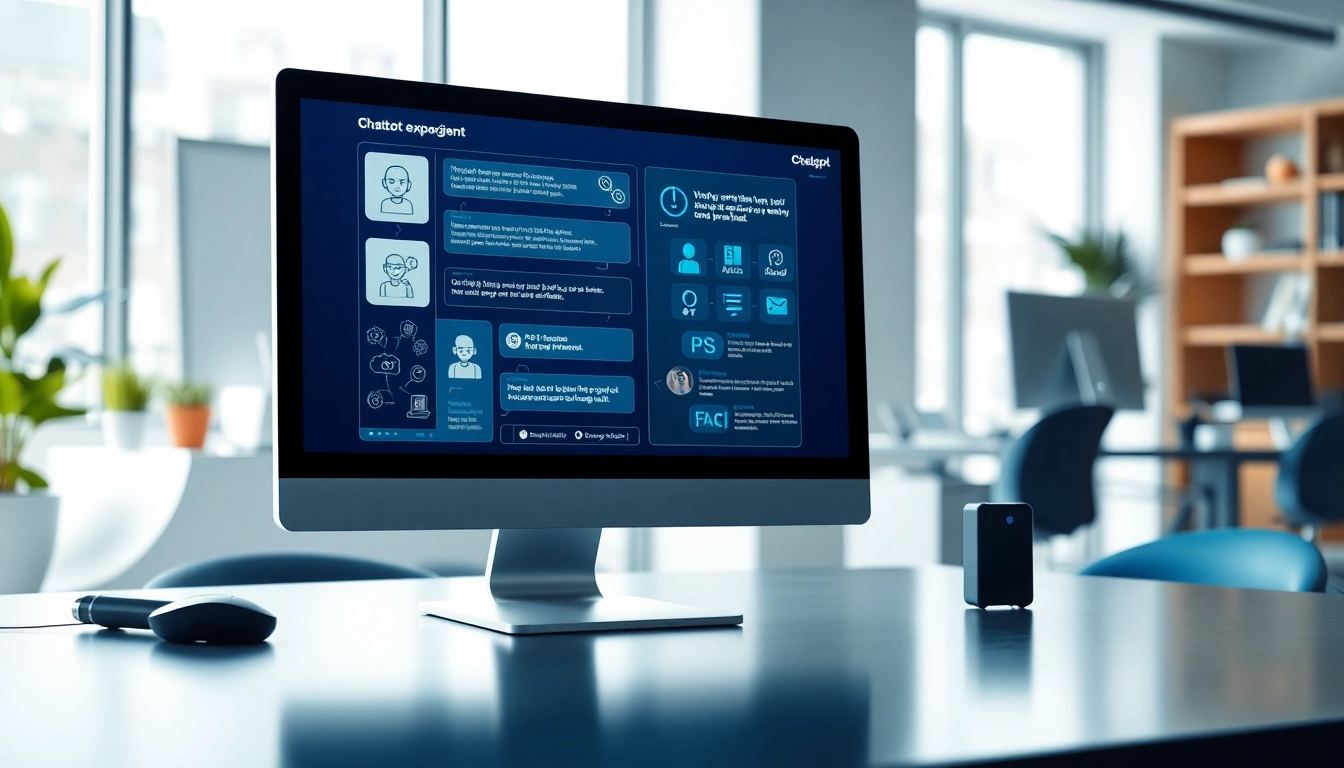Understanding the Basics of ChatGPT Chatbots
1. What is a ChatGPT Chatbot?
ChatGPT chatbots represent a major evolution in conversational AI, distinguished by their ability to understand and generate human-like text responses. Powered by advanced natural language processing (NLP) models, these chatbots harness the capabilities of the GPT (Generative Pre-trained Transformer) architecture. At their core, ChatGPT chatbots are designed to assist in various applications ranging from customer service to personalized user interactions, all while striving for coherence and relevance in conversation. By leveraging these sophisticated models, organizations can create intuitive bots that respond contextually to user inquiries, fostering a richer user experience.
2. How Does ChatGPT Work?
The workings of a ChatGPT chatbot can be boiled down to its underlying architecture and training process. ChatGPT uses a transformer model that processes vast amounts of text data from diverse sources, learning to anticipate language patterns, contextual nuances, and semantic meanings. During training, the model undergoes a process of supervised fine-tuning whereby it learns from annotated datasets, thus improving its communication skills.
Once deployed, these chatbots utilize a powerful inference engine that enables real-time interaction. When a user inputs a query, the model analyzes the text, generates possible responses, and selects the option that aligns best with conversational context. The ability to generate contextually appropriate replies sets ChatGPT apart from traditional rule-based chatbots, allowing users to engage in more fluid and natural conversations.
3. Real World Applications of ChatGPT Technology
ChatGPT technology is making waves across various industries, where its applications are broad and impactful. In the chatgpt chatbot realm, businesses leverage it for customer service automation, significantly reducing wait times and improving customer satisfaction. Additionally, the technology is utilized in educational settings for personalized tutoring, where students can receive tailored help in real-time.
Healthcare applications are also emerging, with chatbots assisting in patient triage, appointment scheduling, and providing preliminary health information. E-commerce platforms benefit as ChatGPT chatbots enhance customer engagement during shopping experiences by offering product recommendations and guiding users through purchasing processes. Essentially, the impact of ChatGPT extends to sectors like travel, finance, and entertainment, where conversational AI facilitates an enriched user journey.
Benefits of Implementing a ChatGPT Chatbot
1. Enhancing Customer Support Services
One of the premier benefits of deploying a ChatGPT chatbot is the extreme enhancement of customer support services. By providing 24/7 availability, businesses can ensure that customer queries are addressed promptly, irrespective of the time zone. This ready access to information helps alleviate user frustration, particularly in scenarios where immediate assistance is needed.
Moreover, ChatGPT chatbots can manage multiple inquiries simultaneously, scaling support capabilities without necessitating additional human resources. Their ability to learn from interactions additionally enables them to refine their responses over time, leading to greater efficiency and customer satisfaction.
2. Streamlining Business Operations
ChatGPT chatbots contribute significantly to streamlining business operations. By automating routine tasks—such as answering frequently asked questions, providing product information, or assisting with booking and reservation processes—employees can focus on complex issues that require human intervention. This shift not only optimizes labor resources but also cuts operational costs.
Additionally, the data collected from interactions with chatbots can provide invaluable insights into customer preferences and behavior, enabling businesses to tailor their offerings more effectively and strategize marketing campaigns based on solid evidence.
3. Improving User Engagement and Retention
With their capacity for personalized interactions, ChatGPT chatbots are adept at improving user engagement and retention rates. They can initiate conversations based on user behavior, ask clarifying questions, and provide recommendations aligned with individual preferences. This tailored experience fosters a sense of connection and value, encouraging users to return.
Moreover, chatbots can engage users through gamification techniques, incentivizing continued interaction through rewards and recognition. In doing so, businesses can cultivate long-term relationships with their customers, significantly boosting brand loyalty.
Strategies for Effective ChatGPT Chatbot Integration
1. Key Considerations for Deployment
When integrating a ChatGPT chatbot into existing systems, organizations must first consider their specific goals and objectives. Identifying the primary use case for the chatbot—be it customer support, lead generation, or another function—is essential to shaping its design and functionality. Following this, businesses should assess the technical infrastructure to ensure compatibility with existing platforms.
Data privacy and compliance are also critical factors; organizations must implement robust security measures to protect user data while adhering to applicable regulations, such as GDPR. Lastly, businesses should plan for continuous monitoring and optimization of the chatbot’s performance, allowing for adjustments based on user behavior and feedback.
2. Customization for Target Audience
To maximize the effectiveness of a ChatGPT chatbot, customization is key. Understanding the target audience—including demographic information, preferences, and common challenges—enables organizations to tailor the chatbot’s tone, language, and functionalities accordingly. This targeted approach ensures that the chatbot resonates with users, enhancing overall engagement.
Furthermore, deploying a user-friendly interface is essential. The chatbot should guide users seamlessly through conversations, utilizing conversational design principles to facilitate smooth interactions. Businesses might also consider integrating multiple languages if they serve diverse populations, thus broadening accessibility.
3. Best Practices for Interaction Design
Effective interaction design can significantly influence the user experience. To achieve this, chatbots should emulate human conversational traits, such as empathy and responsiveness. Providing users with multiple ways to express their queries—whether through text input, voice commands, or predefined options—can promote a more engaging experience.
Additionally, it is crucial to manage user expectations. Implementing features such as “typing indicators” can convey that the chatbot is processing a request, thus reducing user anxiety. Clear, concise response generation is also vital; the chatbot should deliver pertinent information swiftly to maintain engagement levels.
Measuring Success with ChatGPT Chatbots
1. Metrics for Performance Evaluation
To determine the effectiveness of a ChatGPT chatbot, organizations must track a variety of performance metrics. Key performance indicators (KPIs) to assess include user engagement rates, response accuracy, and resolution times. By analyzing these metrics, businesses can gauge whether their chatbot meets user expectations and effectively resolves inquiries.
Furthermore, tracking user retention rates can indicate how well the chatbot fosters ongoing customer relationships. Organizations should also calculate the cost savings achieved from decreased human resource involvement in support tasks, offering tangible proof of the chatbot’s value.
2. Analyzing User Feedback and Adjustments
User feedback plays an instrumental role in refining ChatGPT chatbot performance. Organizations should encourage users to provide constructive feedback on their experiences, capturing qualitative data that can highlight areas for improvement. This may include feedback on response relevance, ease of conversation, or overall satisfaction.
Implementing A/B testing can also prove useful in evaluating different interaction strategies or UI designs. By continually refining the chatbot based on user preferences, businesses can enhance usability and ensure that their chatbot aligns with user expectations.
3. Case Studies of Successful Implementations
Real-world case studies underscore the effectiveness of ChatGPT chatbots across various sectors. For instance, one leading e-commerce brand reported a 30% increase in customer satisfaction following the introduction of a ChatGPT chatbot for 24/7 customer support. The chatbot not only addressed inquiries promptly but also guided users to make informed purchase decisions through personalized recommendations.
In the healthcare sector, a hospital system deployed a ChatGPT chatbot to assist with appointment scheduling and patient inquiries, dramatically reducing administrative burdens. The chatbot efficiently handled routine tasks, allowing staff to focus on complex patient care issues. As a result, the organization reported improved operational efficiency accompanied by faster patient response times.
Future Trends in ChatGPT Technology
1. Innovations on the Horizon
The future of ChatGPT technology promises an array of innovations. As AI continues to evolve, chatbots are expected to become more proficient in understanding contextual subtleties and emotional cues, enabling them to engage in richer and more nuanced conversations. This level of sophistication could lead to the development of avatars or virtual assistants that provide immersive user interaction experiences.
Furthermore, advancements in machine learning will allow chatbots to better understand and adapt to user behavior over time, resulting in increasingly personalized interactions that anticipate user needs seamlessly.
2. Evolving User Expectations
As technology advances, so too do user expectations. Future users will increasingly seek chatbots capable of handling complex queries with minimal input, demanding a near-perfect understanding of context and intent. Users will likely favor chatbots that provide not only accurate information but also empathy and human-like relatability.
Businesses will need to stay ahead by continuously updating their chatbots to meet these evolving expectations, ensuring they provide value beyond simple transactional interactions.
3. Preparing Your Business for Upcoming Changes
To prepare for the future trajectory of ChatGPT technology, organizations should invest in ongoing training and development of their chatbots. This will involve not only enhancing the underlying NLP models but also ensuring integration with tools that allow for real-time data analysis and feedback collection.
Additionally, nurturing a culture of innovation within the organization can empower teams to explore new capabilities and functionalities for their chatbots. By embracing emerging trends and technologies, businesses can remain competitive in a rapidly evolving digital landscape.



